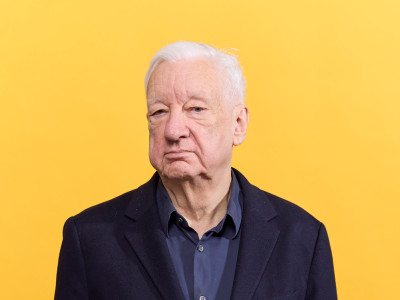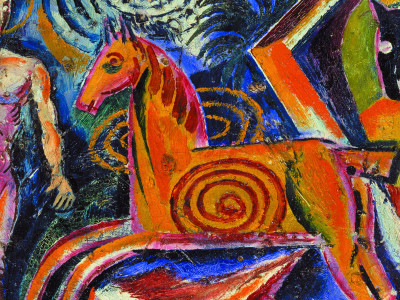
10 art exhibitions to see in February
By Rachel Hughes
Published on 1 February 2020
From Linder’s radical feminist collages and Grayson Perry’s early pots, to the Barbican’s blockbuster survey of masculinity, here are 10 exhibitions you won’t want to miss.

1. Cassi Namoda: Little is Enough for Those in Love
Pippy Houldsworth Gallery, London, 24 January – 7 March 2020
Drawing on photographs, memories and imagination, the new paintings featured in Cassi Namoda’s first UK solo exhibition explore life in the city of Maputo in Mozambique, the artist’s birthplace and home for several years.
Through loosely applied layers of paint, Namoda’s foregrounding of figures against soft palette backgrounds, such as in Little is Enough for Those with Love/Mimi Nakupenda (2019), feels both intimate and arresting.
Family Portrait in Gurué (2019), a frontal family portrait depicted against swathes of sweeping brushstrokes, oscillates somewhere between joy and pain, the clear weather clouded by the figures’ weary expressions. The work was made in response to a photograph of Namoda’s grandparents taken in Gurué, a large tea plantation region, suggesting how the artist attempts to bridge the past and present through her strong narrative compositions, mediating personal family histories with Mozambique’s colonial past.

2. Masculinities: Liberation through Photography
Barbican Art Gallery, London, 20 February – 17 May 2020
In its latest exhibition, the Barbican interrogates the contours of masculinity through some 300 works by over 50 international artists, including Catherine Opie, Sunil Gupta, Robert Mapplethorpe and Isaac Julien RA.
Many of the works on display – such as Peter Hujar’s David Brintzenhofe Applying Makeup (II) (1982) – employ traditional conventions of photographic portraiture to disrupt stereotypical representations of gender and sexuality. Mascara wand in hand and glistening lips agape, Brintzenhofe’s literal tongue in cheek pose reflects the inherently playful nature of drag, poking fun at sexualised advertisements for ‘women’s’ cosmetics, while alluding to the performative nature of gender explored elsewhere in the show.

3. Hans Hofmann: Fury: Painting After the War
BASTIAN, London, 21 February – 23 May 2020
Combining bold, bright colours with contrasting dark tones, Hans Hofmann’s angular abstractions made during and after the Second World War convey the angst and turmoil of the wartime period.
Among these paintings, made from 1942-46 and on show for the first time in the UK, is the anthropomorphic Fury No. 1 (1945), in which a gnarled, jagged bust suspended in a sea of pink hisses an inaudible howl, evoking an atmosphere of insecurity. Counting Lee Krasner and Helen Frankenthaler among his students, the influential teacher’s pivotal paintings from this period foreground the shift from figuration to more ambiguous forms and gestures, securing Hofmann’s place in the development of Abstract Expressionism.

4. To Exalt the Ephemeral: Alina Szapocznikow, 1962-1972
Hauser & Wirth, London, 7 February – 2 May 2020
Sculpture-lampe (Sculpture-Lamp) (1970) – a lipstick-red pout protruding from a bulbous phallus and into a blooming breast-cum-amniotic-sac – is one of many beguiling works on view as part of Alina Szapocznikov’s latest solo UK presentation.
Simultaneously seductive and grotesque, Szapocznikov’s fragmented and erotically charged corporeal lamp illuminates the awkward absurdities of the human form. Tireless in her experiments with unorthodox methods and materials, from car parts to polyester resin, Szapocznikov toyed with impermanence by casting her body in synthetic moulds. Produced during the last decade of the artist’s life, the material innovations on display at Hauser & Wirth reveal Szapocznikov’s obsession with the body as an ephemeral, erogenous zone.

5. Kehinde Wiley: The Yellow Wallpaper
William Morris Gallery, London, 22 February – 25 May 2020
Kehinde Wiley, best known for his presidential portrait of Barack Obama, swaps the White House for the streets of Dalston in a series of new portraits, exclusively of women.
For his first solo presentation at a UK public institution, Wiley will respond to Charlotte Perkins Gilman’s acclaimed feminist text The Yellow Wallpaper (1892), building on a trope in his art in which Wiley engulfs his figures within backdrops of flamboyant wallpaper, such as in Portrait of a Lady (2013).
Deeply engaged with art history, Wiley’s jarring juxtapositions draw attention to the representation of race, power, and gender in historic portraiture by locating black subjects in canonical compositions. Confounding background and foreground, Wiley definitively asserts both the presence of his subjects and a desire to complicate notions of group identity.

6. Grayson Perry: The Pre-Therapy Years
The Holburne Museum, Bath, 24 January – 25 May 2020
The early pots, plates and sculptures produced by Grayson Perry RA during the 1980s–mid-1990s, his so-called ‘pre-therapy years’, are the subject of a new show in Bath.
From a kink-imbued marriage plate to a sacred ceramic turd, these early works offer a rare and uncensored glimpse into the artist’s foundational years. As the title of the show suggests, the works predate his adoption of psychotherapy, but pieces like Self Portrait Cracked and Warped (1985) indicate a burgeoning interest in autobiographical analysis. Featuring an inverted sullen, sunken-eyed self-portrait, Perry’s cracked plate is dominated by an acerbic inscription mocking his own endeavour and the art world at large. The fire damage caused in the kiln, unintentional yet apt, adds to this conceptual self-image, visualising an artist still working things out both personally and creatively.

7. Bill Brandt / Henry Moore
The Hepworth Wakefield, Wakefield, 7 February – 31 May 2020
Whether documenting mining communities or Britain’s megalithic sites, the work of Bill Brandt and Henry Moore reveals a shared sensitivity towards capturing the spirit of place.
Beginning with their first meeting at a 1942 magazine photoshoot, the exhibition charts the artists’ parallel projects through over 200 works, including sculpture, photography, drawings and rare original colour transparencies. Among them is Brandt’s East Sussex (1964), in which the photographer frames porous white limestone to suggest a soft skeletal torso that resonates with Moore’s biomorphic sculpture, highlighting both artists’ enduring interest in the relationship between body and landscape, mass and form.

8. We Will Walk – Art and Resistance in the American South
Turner Contemporary, Margate, 7 February – 3 May 2020
Bringing together a diverse array of work, from sculptural assemblages, photography, quilts and guitars to Civil Rights archive material, We Will Walk highlights the importance of creativity and its power to provoke change through the work of African American artists, makers and thinkers from the Deep South.
Many of these works, produced from the mid-20th century to the present, are going on display for the first time in the UK, including a series of quilts from Gee’s Bend, an isolated hamlet in Alabama inhabited by many descendants of people enslaved on the Pettway plantation. Mary Lee Bendolph’s Basket Weave Variation (c.1990), a bold patchwork of assorted strips of cloth arranged in a syncopated rhythm, speaks to an ethos of communal thriftiness, characterising a creative spirit fostered through necessity, custom and innovation in the face of social inequality.

9. Linderism
Kettle's Yard, Cambridge, 15 February – 26 April 2020
A scene of dreary domesticity violently pierced with a fork, Untitled (1977), displayed as part of a major survey of Linder’s work, characterises the artist’s punk predilection for appropriation and subversion.
Exploiting collage’s disjunctive idiom, Linder’s witty juxtaposition sticks two fingers up to the demure feminine ideal, literalising the expression ‘I’d rather gouge my eyes out’. Picking up her own sharp metal implement, Linder cuts through the confines of gendered representation, sourcing material from interior, lifestyle, fashion and pornography magazines to create bitingly crude collages. Linderism spans five decades of the artist’s practice, taking over and transforming Kettle’s Yard in true punk fashion.

10. Utopias
the Whitworth, Manchester, 31 January – 27 September 2020
Depicting an idyllic town nestled within a serene pastoral setting, J.M.W. Turner’s Llangollen, Denbigshire, Wales (1794) conjures images of a fabled utopia. Yet this vision of a quintessentially British paradise is intrinsically rooted in the past, as a new exhibition of contemporary and historic works at the Whitworth suggests.
Opening on ‘Brexit Day’, the show brings together artists including Jenny Holzer, Thomas Gainsborough and Madge Gill to provocatively examine how myth, memory and nostalgia have informed a particularly British utopia in the nation’s popular imagination. Taking Thomas Moore’s Utopia (1516) as its starting point, Utopias exposes the notion of a perfect world as a paradox at odds with the present, questioning how visual culture has perpetuated this flawed fantasy.
Related articles

5 of the best uses of colour in art and culture
18 September 2024

Michael Craig-Martin: living colour
28 August 2024

Visions from Ukraine
19 June 2024